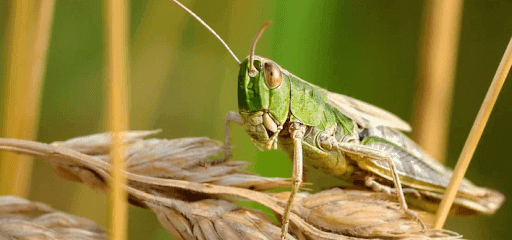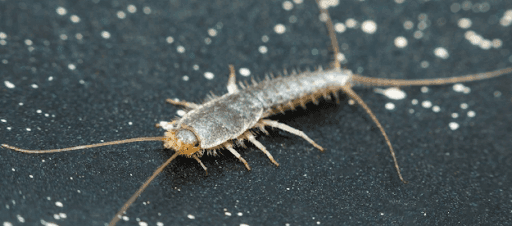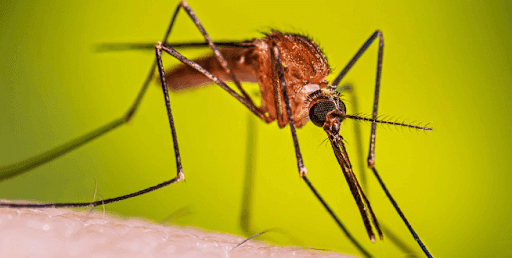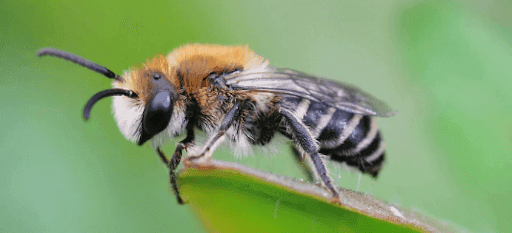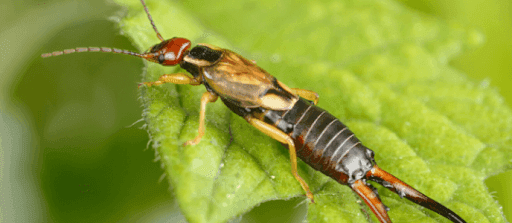昆蟲英文單字大全:從常見單字到專業術語的終極指南
當你在國外看到一隻美麗的蝴蝶時,是否曾經因為不知道如何用英文描述而錯失與外國朋友分享這份驚喜的機會?這正是許多英語學習者面臨的真實困境。昆蟲英文單字不僅是語言學習的重要環節,更是連接科學知識與日常交流的橋樑。
在 PREP 的教學經驗中,我們發現學習者往往忽略了昆蟲英文這個豐富的詞彙領域,然而這些詞彙在日常對話、學術討論、甚至是 IELTS 和 TOEIC 等國際英語檢定中都經常出現。掌握昆蟲的英文表達不僅能提升你的詞彙量,更能幫助你在描述自然環境、討論生態議題或進行科學交流時表達得更加精確生動。這些知識在留學申請的個人陳述、環境科學相關的學術寫作,以及與國際友人的自然話題交流中都具有實用價值。
本文將帶領你從基礎的20個常見昆蟲英文開始,逐步建立完整的昆蟲英文大全知識體系,包含專業的昆蟲學英文術語、生動的俚語表達,以及實用的分類整理。透過系統性的學習方法,你將能夠像昆蟲學家一樣準確使用這些專業詞彙,同時在日常英語交流中展現更豐富的表達能力。現在,讓我們踏上這趟精彩的昆蟲英文學習之旅。

I. 20個生活最常見昆蟲英文
掌握日常生活中最常遇到的昆蟲英文是建立詞彙基礎的第一步。以下精選的20種昆蟲涵蓋了你在室內外最容易遇到的種類,每個單字都配有發音指南和實用例句,讓你能夠立即在對話中運用。
|
昆蟲英文單字 |
意義 |
例句 |
|
Butterfly /ˈbʌtərflaɪ/ |
蝴蝶 |
I saw a beautiful butterfly in the garden.(我在花園裡看到一隻美麗的蝴蝶。) |
|
Bee /biː/ |
蜜蜂 |
The bee is collecting nectar from flowers.(蜜蜂正在花朵上採蜜。) |
|
Ant /ænt/ |
螞蟻 |
Ants are working together to carry food.(螞蟻們正在合作搬運食物。) |
|
Mosquito /məsˈkiːtoʊ/ |
蚊子 |
Mosquitoes are more active at dusk.(蚊子在黃昏時較為活躍。) |
|
Fly /flaɪ/ |
蒼蠅 |
Please close the window to keep flies out.(請關窗戶以免蒼蠅飛進來。) |
|
Spider /ˈspaɪdər/ |
蜘蛛 |
The spider spun a web in the corner.(蜘蛛在角落織了一張網。) |
|
Cockroach /ˈkɑːkroʊtʃ/ |
蟑螂 |
We need to call pest control for the cockroaches.(我們需要找除蟲公司處理蟑螂。) |
|
Dragonfly /ˈdræɡənflaɪ/ |
蜻蜓 |
Dragonflies hover over the pond.(蜻蜓在池塘上方盤旋。) |
|
Moth /mɔːθ/ |
蛾 |
The moth was attracted to the lamp.(蛾被燈光吸引。) |
|
Cricket /ˈkrɪkɪt/ |
蟋蟀 |
I can hear crickets chirping at night.(我能聽到蟋蟀在夜晚鳴叫。) |
|
Beetle /ˈbiːtl/ |
甲蟲 |
The beetle has a shiny black shell.(這隻甲蟲有著閃亮的黑色外殼。) |
|
Ladybug /ˈleɪdibʌɡ/ |
瓢蟲 |
Ladybugs are beneficial insects for gardens.(瓢蟲對花園是有益的昆蟲。) |
|
Grasshopper /ˈɡræshɑːpər/ |
蚱蜢 |
The grasshopper jumped high into the air.(蚱蜢高高跳到空中。) |
|
Wasp /wɑːsp/ |
黃蜂 |
Be careful, there's a wasp near the picnic table.(小心,野餐桌附近有隻黃蜂。) |
|
Aphid /ˈeɪfɪd/ |
蚜蟲 |
Aphids are damaging the rose bushes.(蚜蟲正在危害玫瑰叢。) |
|
Termite /ˈtɜːrmaɪt/ |
白蟻 |
Termites can cause serious damage to wooden structures.(白蟻會對木製結構造成嚴重損害。) |
|
Flea /fliː/ |
跳蚤 |
My dog needs flea treatment.(我的狗需要除蚤治療。) |
|
Tick /tɪk/ |
蚤 |
Check for ticks after hiking in the woods.(在森林健行後要檢查是否有壁蝨。) |
|
Earwig /ˈɪrwɪɡ/ |
蠼螋 |
Earwigs are commonly found in damp places.(蠼螋常見於潮濕的地方。) |
|
Fruit fly /fruːt flaɪ/ |
果蠅 |
Fruit flies are attracted to overripe bananas.(果蠅會被過熟的香蕉吸引。) |
這些昆蟲英文單字構成了日常對話的重要基礎,當你能夠自然地使用這些詞彙描述周遭環境時,你的英語表達將變得更加生動具體。
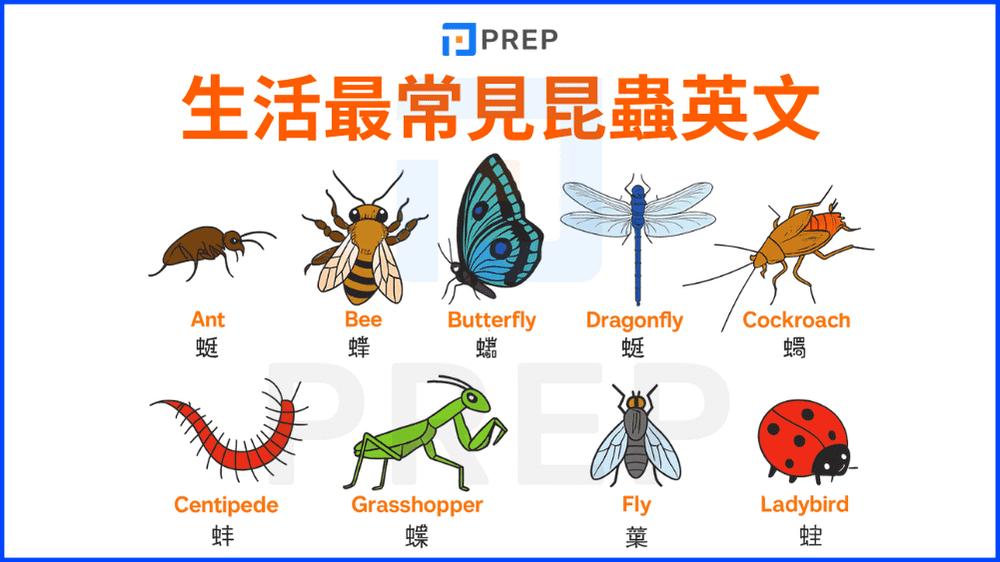
II. 昆蟲英文單字大全
在建立基礎詞彙之後,讓我們深入探索更廣泛的昆蟲英文世界。透過科學分類的方式整理這些單字,你將能夠更系統性地掌握昆蟲的英文表達方式,同時理解不同昆蟲的特徵與生態角色。
1. 有翅昆蟲
有翅昆蟲代表了昆蟲界中最具活動性的一群,牠們的飛行能力使其能夠在廣闊的環境中生存繁衍。這類昆蟲的英文詞彙往往與其飛行特徵或翅膀構造相關,掌握這些詞彙將幫助你準確描述各種飛行昆蟲的特徵和行為。
|
昆蟲英文單字 |
意義 |
例句 |
|
Bumblebee /ˈbʌmblbiː/ |
大黃蜂 |
The bumblebee buzzes loudly as it flies from flower to flower.(大黃蜂飛舞在花朵間時發出響亮的嗡嗡聲。) |
|
Honeybee /ˈhʌnibiː/ |
蜜蜂 |
Honeybees play a crucial role in pollinating crops.(蜜蜂在農作物授粉中扮演關鍵角色。) |
|
Hornet /ˈhɔːrnɪt/ |
胡蜂 |
The hornet's sting can be very painful.(胡蜂的螫刺可能非常疼痛。) |
|
Mayfly /ˈmeɪflaɪ/ |
蜉蝣 |
Mayflies have one of the shortest adult lifespans in the insect world.(蜉蝣的成蟲壽命是昆蟲界中最短的之一。) |
|
Damselfly /ˈdæmzəlflaɪ/ |
豆娘 |
Damselflies fold their wings along their body when at rest.(豆娘休息時會將翅膀沿著身體摺疊。) |
|
Hoverfly /ˈhʌvərflaɪ/ |
食蚜蠅 |
Hoverflies are excellent mimics of bees and wasps.(食蚜蠅是蜜蜂和黃蜂的絕佳模仿者。) |
|
Crane fly /kreɪn flaɪ/ |
大蚊 |
Crane flies are often mistaken for giant mosquitoes.(大蚊常被誤認為是巨型蚊子。) |
|
Caddisfly /ˈkædɪsflaɪ/ |
石蛾 |
Caddisfly larvae build protective cases underwater.(石蛾幼蟲在水中建造保護性的殼。) |
|
Stonefly /ˈstoʊnflaɪ/ |
石蠅 |
Stoneflies are indicators of good water quality.(石蠅是良好水質的指標。) |
|
Lacewing /ˈleɪswɪŋ/ |
草蛉 |
Green lacewings have delicate, transparent wings.(綠草蛉有精緻透明的翅膀。) |
|
Swallowtail /ˈswɑːloʊteɪl/ |
鳳蝶 |
The swallowtail butterfly has distinctive tail-like extensions on its wings.(鳳蝶的翅膀有獨特的尾狀延伸。) |
|
Carpenter bee /ˈkɑːrpəntər biː/ |
木蜂 |
Carpenter bees bore holes in wood to create their nests.(木蜂在木材中鑽孔築巢。) |
|
Leafhopper /ˈliːfhɑːpər/ |
葉蟬 |
Leafhoppers can damage plants by sucking their sap.(葉蟬會吸取植物汁液而造成損害。) |
|
Cicada /sɪˈkeɪdə/ |
蟬 |
Cicadas emerge from underground after spending years as nymphs.(蟬在地下度過若蟲期多年後才羽化。) |
|
Dobsonfly /ˈdɑːbsənflaɪ/ |
魚蛉 |
Male dobsonflies have impressive mandibles for display.(雄性魚蛉有令人印象深刻的大顎用於展示。) |
|
Antlion /ˈæntlaɪən/ |
蟻獅 |
Antlion larvae create conical traps in sand to catch prey.(蟻獅幼蟲在沙中創造錐形陷阱捕獲獵物。) |
|
Thrips /θrɪps/ |
薊馬 |
Thrips are tiny insects that can damage greenhouse plants.(薊馬是會損害溫室植物的微小昆蟲。) |
|
Aphid /ˈeɪfɪd/ |
蚜蟲 |
Winged aphids spread to new host plants.(有翅蚜蟲會擴散到新的寄主植物。) |
|
Whitefly /ˈwaɪtflaɪ/ |
粉蝨 |
Whiteflies are serious pests of tomato plants.(粉蝨是番茄植物的嚴重害蟲。) |
|
Sawfly /ˈsɔːflaɪ/ |
葉蜂 |
Sawfly larvae look similar to caterpillars but have more legs.(葉蜂幼蟲看起來像毛蟲但有更多的腿。) |
|
Scorpionfly /ˈskɔːrpiənflaɪ/ |
蠍蛉 |
Male scorpionflies have enlarged genital segments.(雄性蠍蛉有膨大的生殖節段。) |
|
Dance fly /dæns flaɪ/ |
舞虻 |
Dance flies perform elaborate mating dances.(舞虻會表演精緻的求偶舞蹈。) |
|
Fairyfly /ˈferiwaɪ/ |
纓小蜂 |
Fairyflies are among the smallest insects in the world.(纓小蜂是世界上最小的昆蟲之一。) |
|
Hangingfly /ˈhæŋɪŋflaɪ/ |
懸蛉 |
Hangingflies catch prey with their long legs while hanging from vegetation.(懸蛉懸掛在植物上用長腿捕獲獵物。) |
|
Snakefly /ˈsneɪkflaɪ/ |
蛇蛉 |
Snakeflies have elongated necks that they can bend like snakes.(蛇蛉有細長的頸部,可以像蛇一樣彎曲。) |
2. 無翅昆蟲
無翅昆蟲雖然缺乏飛行能力,但牠們透過其他方式在生態系統中找到自己的生存之道。這些昆蟲的英文名稱往往反映了牠們的移動方式或生活習性,理解這些術語將幫助你準確描述那些依靠爬行、跳躍或其他方式移動的昆蟲。
|
昆蟲英文單字 |
意義 |
例句 |
|
Silverfish /ˈsɪlvərfɪʃ/ |
蠹魚 |
Silverfish are often found in bathrooms and basements.(蠹魚常見於浴室和地下室。) |
|
Springtail /ˈsprɪŋteɪl/ |
跳蟲 |
Springtails help decompose organic matter in soil.(跳蟲幫助分解土壤中的有機物質。) |
|
Booklouse /ˈbʊklaʊs/ |
書蝨 |
Booklice feed on mold and organic materials in old books.(書蝨以舊書中的黴菌和有機物為食。) |
|
Worker ant /ˈwɜːrkər ænt/ |
工蟻 |
Worker ants are responsible for foraging and nest maintenance.(工蟻負責覓食和維護蟻巢。) |
|
Flea /fliː/ |
跳蚤 |
Fleas are excellent jumpers despite being wingless.(跳蚤雖然無翅但是出色的跳躍者。) |
|
Head louse /hed laʊs/ |
頭蝨 |
Head lice are common parasites in school children.(頭蝨是學齡兒童常見的寄生蟲。) |
|
Body louse /ˈbɑːdi laʊs/ |
體蝨 |
Body lice live in clothing and feed on human blood.(體蝨生活在衣物中並以人血為食。) |
|
Firebrat /ˈfaɪərrbræt/ |
火衣魚 |
Firebrats prefer warm, humid environments like near furnaces.(火衣魚偏好溫暖潮濕的環境如火爐附近。) |
|
Two-pronged bristletail /tuː prɔːŋd ˈbrɪsəlteɪl/ |
雙尾蟲 |
Two-pronged bristletails are primitive wingless insects.(雙尾蟲是原始的無翅昆蟲。) |
|
Rock crawler /rɑːk ˈkrɔːlər/ |
岩蟲 |
Rock crawlers live in cold, rocky environments.(岩蟲生活在寒冷的岩石環境中。) |
|
Snow flea /snoʊ fliː/ |
雪蚤 |
Snow fleas can be seen jumping on snow during winter.(雪蚤在冬天可以看到在雪上跳躍。) |
|
Proturan /prəˈtjʊrən/ |
原尾蟲 |
Proturans are tiny soil-dwelling insects.(原尾蟲是微小的土壤昆蟲。) |
|
Diplura /dɪˈplʊrə/ |
雙尾目昆蟲 |
Diplura are found in soil and leaf litter.(雙尾目昆蟲見於土壤和落葉中。) |
|
Cave cricket /keɪv ˈkrɪkɪt/ |
洞穴蟋蟀 |
Cave crickets have long antennae to navigate in darkness.(洞穴蟋蟀有長觸角在黑暗中導航。) |
|
Earwig nymph /ˈɪrwɪɡ nɪmf/ |
蠼螋若蟲 |
Earwig nymphs resemble adults but lack wings.(蠼螋若蟲像成蟲但缺少翅膀。) |
|
Psocid /ˈsoʊsɪd/ |
嚙蟲 |
Psocids are often called barklice when found outdoors.(嚙蟲在戶外發現時常被稱為樹皮蝨。) |
|
Bed bug /bed bʌɡ/ |
臭蟲 |
Bed bugs are notorious wingless parasites of humans.(臭蟲是惡名昭彰的人類無翅寄生蟲。) |
|
Chigger /ˈtʃɪɡər/ |
恙蟲 |
Chiggers are the larvae of certain mites.(恙蟲是某些蟎蟲的幼蟲。) |
|
Flour beetle larva /flaʊər ˈbiːtl ˈlɑːrvə/ |
麵粉甲蟲幼蟲 |
Flour beetle larvae are wingless and feed on stored grains.(麵粉甲蟲幼蟲無翅並以儲存穀物為食。) |
|
Clothes moth larva /kloʊðz mɔːθ ˈlɑːrvə/ |
衣蛾幼蟲 |
Clothes moth larvae damage woolen fabrics.(衣蛾幼蟲會損害毛織品。) |
|
Velvet ant /ˈvelvɪt ænt/ |
絨蟻 |
Female velvet ants are actually wingless wasps.(雌性絨蟻實際上是無翅黃蜂。) |
|
Twisted-wing parasite /ˈtwɪstɪd wɪŋ ˈpærəsaɪt/ |
扭翅蟲 |
Female twisted-wing parasites are wingless and live inside other insects.(雌性扭翅蟲無翅並生活在其他昆蟲體內。) |
|
Grylloblattid /ɡrɪˈloʊblætɪd/ |
蛩蠊 |
Grylloblattids are wingless insects found in cold mountainous regions.(蛩蠊是生活在寒冷山區的無翅昆蟲。) |
|
Webspinner /ˈwebspɪnər/ |
紡足蟲 |
Male webspinners may have wings while females are always wingless.(雄性紡足蟲可能有翅膀而雌性總是無翅的。) |
3. 有益昆蟲
有益昆蟲在生態平衡中扮演重要角色,無論是授粉、捕食害蟲或分解有機物,牠們都為人類和環境帶來正面影響。認識這些昆蟲的英文名稱有助於你在討論環保話題時更加準確,並理解生物防治和永續農業的概念。
|
昆蟲英文單字 |
意義 |
例句 |
|
Praying mantis /ˈpreɪɪŋ ˈmæntɪs/ |
螳螂 |
The praying mantis is an excellent predator of garden pests.(螳螂是花園害蟲的絕佳天敵。) |
|
Lacewing /ˈleɪswɪŋ/ |
草蛉 |
Lacewing larvae are voracious aphid eaters.(草蛉幼蟲是貪婪的蚜蟲捕食者。) |
|
Ground beetle /ɡraʊnd ˈbiːtl/ |
步行蟲 |
Ground beetles help control slug and caterpillar populations.(步行蟲幫助控制蛞蝓和毛蟲的數量。) |
|
Parasitic wasp /pærəˈsɪtɪk wɑːsp/ |
寄生蜂 |
Parasitic wasps are used in biological pest control.(寄生蜂被用於生物害蟲防治。) |
|
Assassin bug /əˈsæsən bʌɡ/ |
獵蝽 |
Assassin bugs prey on many harmful insects.(獵蝽捕食許多有害昆蟲。) |
|
Syrphid fly /ˈsɪrfɪd flaɪ/ |
食蚜蠅 |
Syrphid fly larvae consume large numbers of aphids.(食蚜蠅幼蟲會消耗大量蚜蟲。) |
|
Minute pirate bug /maɪˈnut paɪrət bʌɡ/ |
小花蝽 |
Minute pirate bugs are tiny predators of spider mites.(小花蝽是蜘蛛蟎的微小捕食者。) |
|
Rove beetle /roʊv ˈbiːtl/ |
隱翅蟲 |
Rove beetles feed on fly eggs and larvae.(隱翅蟲以蠅卵和幼蟲為食。) |
|
Ichneumon wasp /ɪkˈnjuːmən wɑːsp/ |
姬蜂 |
Ichneumon wasps parasitize caterpillars.(姬蜂寄生於毛蟲。) |
|
Big-eyed bug /bɪɡ aɪd bʌɡ/ |
大眼蝽 |
Big-eyed bugs are general predators in agricultural fields.(大眼蝽是農田中的通用捕食者。) |
|
Braconid wasp /ˈbrækənɪd wɑːsp/ |
小繭蜂 |
Braconid wasps are important biological control agents.(小繭蜂是重要的生物防治代理。) |
|
Robber fly /ˈrɑːbər flaɪ/ |
食蟲虻 |
Robber flies catch other insects in mid-flight.(食蟲虻在飛行中捕捉其他昆蟲。) |
|
Soldier beetle /ˈsoʊldʒər ˈbiːtl/ |
花螢 |
Soldier beetles eat soft-bodied pest insects.(花螢吃軟體害蟲。) |
|
Spined soldier bug /spaɪnd ˈsoʊldʒər bʌɡ/ |
刺猛蝽 |
Spined soldier bugs control caterpillar infestations.(刺猛蝽控制毛蟲侵害。) |
|
Tachinid fly /təˈkaɪnɪd flaɪ/ |
寄生蠅 |
Tachinid flies parasitize many pest caterpillars.(寄生蠅寄生於許多害蟲毛蟲。) |
|
Thread-waisted wasp /θred ˈweɪstɪd wɑːsp/ |
細腰蜂 |
Thread-waisted wasps provision their nests with paralyzed caterpillars.(細腰蜂用麻痺的毛蟲為巢提供食物。) |
|
Carabid beetle /ˈkærəbɪd ˈbiːtl/ |
步甲 |
Carabid beetles are nocturnal predators of many pests.(步甲是許多害蟲的夜行捕食者。) |
|
Dung beetle /dʌŋ ˈbiːtl/ |
糞金龜 |
Dung beetles help recycle nutrients in ecosystems.(糞金龜幫助生態系統回收營養。) |
|
Burying beetle /ˈberiɪŋ ˈbiːtl/ |
埋葬蟲 |
Burying beetles dispose of small animal carcasses.(埋葬蟲處理小動物屍體。) |
|
Mason bee /ˈmeɪsən biː/ |
壁蜂 |
Mason bees are excellent pollinators of fruit trees.(壁蜂是果樹的優秀授粉者。) |
|
Leafcutter bee /ˈliːfkʌtər biː/ |
切葉蜂 |
Leafcutter bees are important native pollinators.(切葉蜂是重要的本土授粉者。) |
|
Checkered beetle /ˈtʃekərd ˈbiːtl/ |
郭公蟲 |
Checkered beetles prey on bark beetle larvae.(郭公蟲捕食樹皮甲蟲幼蟲。) |
|
Anthocorid bug /ænˈθɔːkərɪd bʌɡ/ |
花蝽 |
Anthocorid bugs are important predators in greenhouses.(花蝽是溫室中的重要捕食者。) |
|
Chalcid wasp /ˈkælsɪd wɑːsp/ |
小蜂 |
Chalcid wasps parasitize many different pest insects.(小蜂寄生於許多不同的害蟲。) |
4. 有害昆蟲
有害昆蟲可能對農作物、建築物或人類健康造成威脅。掌握這些昆蟲的英文表達有助於你在需要時準確描述問題並尋求適當的解決方案,這些知識在農業、公共衛生和害蟲管理領域特別重要。
|
昆蟲英文單字 |
意義 |
例句 |
|
Colorado potato beetle /kələˈrædoʊ pəˈteɪtoʊ ˈbiːtl/ |
科羅拉多金花蟲 |
The Colorado potato beetle can destroy entire potato crops.(科羅拉多金花蟲能夠摧毀整片馬鈴薯作物。) |
|
Corn borer /kɔːrn ˈbɔːrər/ |
玉米螟 |
Farmers use various methods to combat corn borer infestations.(農民使用各種方法對抗玉米螟的侵害。) |
|
Locust /ˈloʊkəst/ |
蝗蟲 |
Locust swarms can devastate agricultural areas.(蝗蟲群能夠摧毀農業區域。) |
|
Carpet beetle /ˈkɑːrpɪt ˈbiːtl/ |
地毯甲蟲 |
Carpet beetles can damage woolen fabrics and carpets.(地毯甲蟲會損害毛織品和地毯。) |
|
Japanese beetle /dʒæpəˈniːz ˈbiːtl/ |
日本金龜子 |
Japanese beetles are destructive pests of many plants.(日本金龜子是許多植物的破壞性害蟲。) |
|
Gypsy moth /ˈdʒɪpsi mɔːθ/ |
舞毒蛾 |
Gypsy moth caterpillars can defoliate entire forests.(舞毒蛾毛蟲能使整片森林落葉。) |
|
Boll weevil /boʊl ˈwiːvəl/ |
棉花象鼻蟲 |
The boll weevil devastated cotton crops in the southern United States.(棉花象鼻蟲摧毀了美國南部的棉花作物。) |
|
Emerald ash borer /ˈemərəld æʃ ˈbɔːrər/ |
綠寶石蠟樹蟲 |
The emerald ash borer has killed millions of ash trees.(綠寶石蠟樹蟲已經殺死了數百萬棵梣樹。) |
|
Codling moth /ˈkɑːdlɪŋ mɔːθ/ |
蘋果蠹蛾 |
Codling moth larvae create worms in apples.(蘋果蠹蛾幼蟲在蘋果中形成蟲孔。) |
|
Chinch bug /tʃɪntʃ bʌɡ/ |
臭椿象 |
Chinch bugs damage lawn grasses by sucking plant juices.(臭椿象吸取植物汁液損害草坪。) |
|
Army worm /ˈɑːrmi wɜːrm/ |
黏蟲 |
Army worms can strip corn fields bare overnight.(黏蟲能在一夜之間剝光玉米田。) |
|
Cucumber beetle /ˈkjuːkʌmbər ˈbiːtl/ |
黃瓜甲蟲 |
Cucumber beetles spread bacterial wilt disease.(黃瓜甲蟲傳播細菌性萎蔫病。) |
|
Aphid /ˈeɪfɪd/ |
蚜蟲 |
Aphids weaken plants by sucking their sap.(蚜蟲吸取植物汁液使植物衰弱。) |
|
Scale insect /skeɪl ˈɪnsekt/ |
介殼蟲 |
Scale insects attack many ornamental plants.(介殼蟲攻擊許多觀賞植物。) |
|
Mealybug /ˈmiːlibʌɡ/ |
粉介殼蟲 |
Mealybugs secrete a waxy substance that covers their bodies.(粉介殼蟲分泌蠟質物覆蓋身體。) |
|
Squash bug /skwɑːʃ bʌɡ/ |
南瓜椿象 |
Squash bugs damage cucurbit crops.(南瓜椿象損害瓜科作物。) |
|
Stink bug /stɪŋk bʌɡ/ |
椿象 |
Brown marmorated stink bugs are invasive agricultural pests.(褐斑椿象是入侵性農業害蟲。) |
|
Bagworm /ˈbæɡwɜːrm/ |
袋蛾 |
Bagworms can defoliate evergreen trees.(袋蛾能使常綠樹木落葉。) |
|
Cabbage worm /ˈkæbɪdʒ wɜːrm/ |
菜青蟲 |
Cabbage worms are common pests of brassica crops.(菜青蟲是十字花科作物的常見害蟲。) |
|
Cutworm /ˈkʌtwɜːrm/ |
地老虎 |
Cutworms cut through young plant stems at soil level.(地老虎在土壤表面切斷幼苗莖部。) |
|
Tarnished plant bug /ˈtɑːrnɪʃt plænt bʌɡ/ |
盲椿象 |
Tarnished plant bugs cause dimpling in developing fruits.(盲椿象造成發育中果實的凹陷。) |
|
European corn borer /jʊrəˈpiːən kɔːrn ˈbɔːrər/ |
歐洲玉米螟 |
European corn borers tunnel through corn stalks.(歐洲玉米螟在玉米稈中鑽洞。) |
|
Hessian fly /ˈhɛʃən flaɪ/ |
麥稈蠅 |
Hessian flies are serious pests of wheat crops.(麥稈蠅是小麥作物的嚴重害蟲。) |
|
Wireworm /ˈwaɪərwɜːrm/ |
金針蟲 |
Wireworms attack the roots of many crop plants.(金針蟲攻擊許多作物的根部。) |
|
Horn fly /hɔːrn flaɪ/ |
角蠅 |
Horn flies are blood-sucking pests of cattle.(角蠅是牛隻的吸血害蟲。) |
除了英語昆蟲之外,您還可以參考 PREP 的文章《動物英文名稱大全:學習最常見動物的英語詞彙》,以進一步充實同主題的詞彙量!
III. 解構昆蟲英文的身體構造與生命週期
理解昆蟲的身體構造和生命週期不僅能豐富你的科學詞彙,更能幫助你在英語環境中進行更深入的學術討論。這些專業術語是昆蟲學英文的核心,掌握它們將大幅提升你的專業英語表達能力。當你能夠準確使用這些術語時,你就能像生物學家一樣精確地描述昆蟲的特徵和行為模式。
1. 昆蟲英文的身體構造
昆蟲的身體結構遵循標準的三段式設計,每個部位都有其專門的英文術語。理解這些解剖學詞彙不僅幫助你在科學討論中表達準確,更能讓你深入理解昆蟲如何適應不同的生存環境。
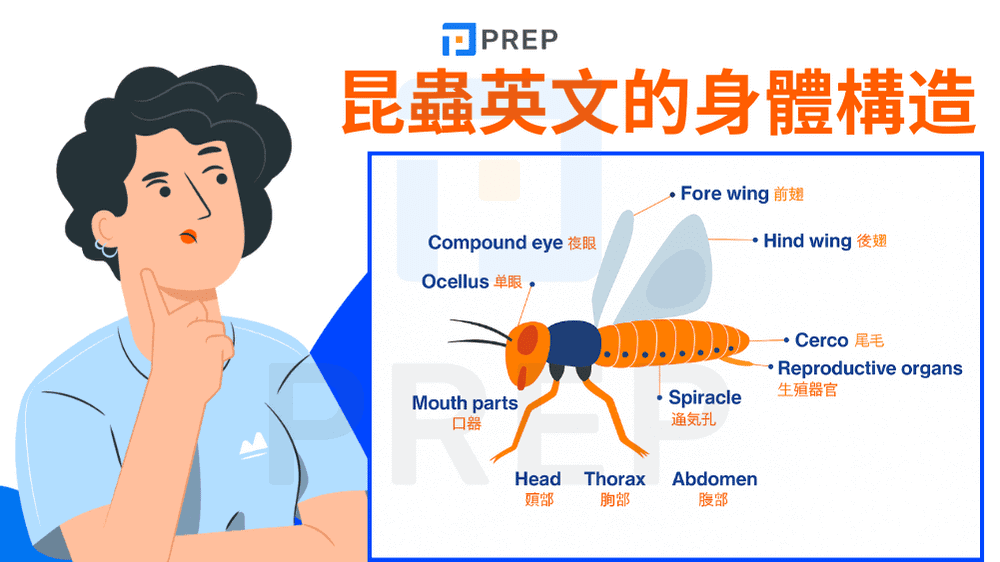
|
昆蟲英文單字 |
意義 |
例句 |
|
Head /hed/ |
頭部 |
The insect's head contains the brain and sensory organs.(昆蟲的頭部包含大腦和感覺器官。) |
|
Thorax /ˈθɔːræks/ |
胸部 |
The thorax is the middle section where legs and wings attach.(胸部是腿和翅膀附著的中間部分。) |
|
Abdomen /ˈæbdəmən/ |
腹部 |
The abdomen houses the digestive and reproductive systems.(腹部容納消化和生殖系統。) |
|
Compound eyes /ˈkɑːmpaʊnd aɪz/ |
複眼 |
Compound eyes consist of thousands of individual lenses.(複眼由數千個獨立鏡片組成。) |
|
Antennae /ænˈteniː/ |
觸角 |
Antennae serve as chemical and tactile sensors.(觸角作為化學和觸覺感應器。) |
|
Mandibles /ˈmændɪbəlz/ |
大顎 |
Mandibles are the primary chewing mouthparts.(大顎是主要的咀嚼口器。) |
|
Maxillae /mækˈsɪliː/ |
小顎 |
Maxillae assist in food manipulation and tasting.(小顎協助食物處理和品嚐。) |
|
Labium /ˈleɪbiəm/ |
下唇 |
The labium forms the lower lip of the mouth.(下唇形成口部的下嘴唇。) |
|
Proboscis /prəˈbɑːsɪs/ |
喙 |
Butterflies use their proboscis to sip nectar.(蝴蝶用喙吸取花蜜。) |
|
Prothorax /ˈproʊθɔːræks/ |
前胸 |
The prothorax bears the first pair of legs.(前胸承載第一對腿。) |
|
Mesothorax /ˈmezoʊθɔːræks/ |
中胸 |
The mesothorax typically carries the forewings.(中胸通常承載前翅。) |
|
Metathorax /ˈmetəθɔːræks/ |
後胸 |
The metathorax supports the hindwings and last pair of legs.(後胸支撐後翅和最後一對腿。) |
|
Forewings /ˈfɔːrwɪŋz/ |
前翅 |
Beetles have hardened forewings called elytra.(甲蟲有硬化的前翅稱為鞘翅。) |
|
Hindwings /ˈhaɪndwɪŋz/ |
後翅 |
Hindwings are often used for actual flight.(後翅通常用於實際飛行。) |
|
Elytra /ˈelɪtrə/ |
鞘翅 |
Elytra protect the delicate hindwings underneath.(鞘翅保護下方精緻的後翅。) |
|
Femur /ˈfiːmər/ |
股節 |
The femur is the thickest segment of the insect leg.(股節是昆蟲腿部最粗的節段。) |
|
Tibia /ˈtɪbiə/ |
脛節 |
The tibia often bears spines for gripping surfaces.(脛節常有刺用於抓握表面。) |
|
Tarsus /ˈtɑːrsəs/ |
跗節 |
The tarsus is the foot segment with claws.(跗節是帶爪的足部節段。) |
|
Spiracles /ˈspɪrəkəlz/ |
氣門 |
Spiracles are breathing pores along the abdomen.(氣門是沿腹部的呼吸孔。) |
|
Cerci /ˈsɜːrsaɪ/ |
尾鬚 |
Cerci are sensory appendages at the rear of the abdomen.(尾鬚是腹部後端的感覺附肢。) |
2. 昆蟲英文的生命週期
昆蟲的生命週期展現了自然界中最令人驚嘆的變態過程,相關的英文術語是理解昆蟲學的關鍵。掌握這些詞彙不僅能幫助你描述昆蟲的發育過程,更能讓你理解生物多樣性和適應性的深層機制。
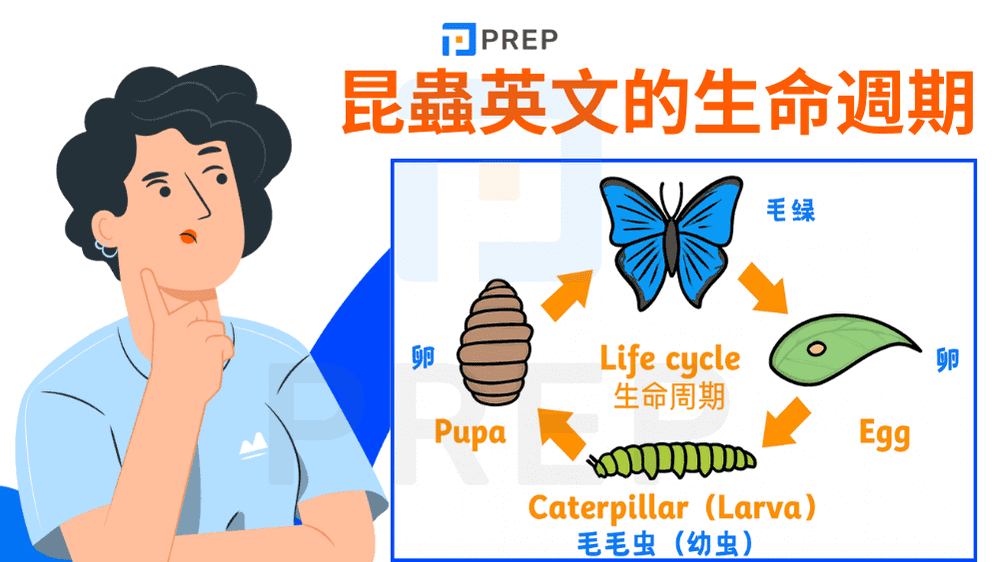
|
昆蟲英文單字 |
意義 |
例句 |
|
Complete metamorphosis /kəmˈpliːt ˌmetəˈmɔːrfəsɪs/ |
完全變態 |
Complete metamorphosis involves four distinct life stages.(完全變態包含四個截然不同的生命階段。) |
|
Incomplete metamorphosis /ɪnkəmˈpliːt ˌmetəˈmɔːrfəsɪs/ |
不完全變態 |
Grasshoppers undergo incomplete metamorphosis.(蚱蜢經歷不完全變態。) |
|
Egg stage /eɡ steɪdʒ/ |
卵期 |
The egg stage is the first phase of insect development.(卵期是昆蟲發育的第一階段。) |
|
Larval stage /ˈlɑːrvəl steɪdʒ/ |
幼蟲期 |
The larval stage is primarily focused on growth and feeding.(幼蟲期主要專注於成長和攝食。) |
|
Pupal stage /ˈpjuːpəl steɪdʒ/ |
蛹期 |
During the pupal stage, the insect undergoes internal reorganization.(在蛹期,昆蟲經歷內部重組。) |
|
Adult stage /əˈdʌlt steɪdʒ/ |
成蟲期 |
The adult stage focuses on reproduction and dispersal.(成蟲期專注於繁殖和擴散。) |
|
Larva /ˈlɑːrvə/ |
幼蟲 |
The larva feeds continuously to accumulate energy for metamorphosis.(幼蟲持續攝食以積累變態所需的能量。) |
|
Caterpillar /ˈkætərpɪlər/ |
毛蟲 |
A caterpillar is the larval stage of butterflies and moths.(毛蟲是蝴蝶和蛾的幼蟲階段。) |
|
Pupa /ˈpjuːpə/ |
蛹 |
The pupa appears inactive but intense changes occur inside.(蛹看起來不活躍但內部發生劇烈變化。) |
|
Chrysalis /ˈkrɪsəlɪs/ |
蝶蛹 |
The chrysalis is the pupal stage of a butterfly.(蝶蛹是蝴蝶的蛹期。) |
|
Cocoon /kəˈkuːn/ |
繭 |
Moths often spin a cocoon around their pupa.(蛾常在蛹周圍結繭。) |
|
Imago /ɪˈmeɪɡoʊ/ |
成蟲 |
The imago is the final, sexually mature form.(成蟲是最終的性成熟形態。) |
|
Nymph /nɪmf/ |
若蟲 |
A nymph resembles the adult but lacks wings.(若蟲像成蟲但缺少翅膀。) |
|
Instar /ˈɪnstɑːr/ |
齡期 |
Each instar represents a growth stage between molts.(每個齡期代表蛻皮間的成長階段。) |
|
Molting /ˈmoʊltɪŋ/ |
蛻皮 |
Molting allows the insect to grow larger.(蛻皮讓昆蟲能夠長得更大。) |
|
Ecdysis /ˈekdəsɪs/ |
蛻殼 |
Ecdysis is the process of shedding the old exoskeleton.(蛻殼是脫掉舊外骨骼的過程。) |
|
Exoskeleton /ˌeksoʊˈskelətən/ |
外骨骼 |
The exoskeleton provides protection and muscle attachment points.(外骨骼提供保護和肌肉附著點。) |
|
Pupation /pjuːˈpeɪʃən/ |
化蛹 |
Pupation marks the transition from larva to adult.(化蛹標誌著從幼蟲到成蟲的轉變。) |
|
Emergence /ɪˈmɜːrdʒəns/ |
羽化 |
Emergence is when the adult insect breaks free from the pupal case.(羽化是成蟲從蛹殼中破出的過程。) |
|
Eclosion /ɪˈkloʊʒən/ |
孵化 |
Eclosion refers to the hatching from an egg or emerging from a pupa.(孵化指從卵中孵出或從蛹中羽化。) |
這些專業術語構成了昆蟲學英文的核心詞彙系統,當你熟練掌握這些概念時,你就能夠像專業的昆蟲學家一樣準確描述昆蟲的形態特徵和生命歷程,這種精確性在科學溝通中極為重要。
IV. 英語關於小蟲子的詞彙
在昆蟲世界中,最容易被忽略卻極其重要的就是那些微小的蟲子。這些小蟲子雖然肉眼難以察覺,但牠們在生態系統中扮演著不可或缺的角色。掌握這些微小昆蟲的英文詞彙不僅能擴展你的專業詞彙量,更能幫助你在討論生態學、微生物學或害蟲防治時表達得更加精確。這些詞彙特別適合用於科學研究、農業討論或環境保護相關的英語交流中。
|
小蟲子的英文單字 |
意義 |
例句 |
|
Midge /mɪdʒ/ |
搖蚊 |
Midges form swarms near water sources during mating season.(搖蚊在交配季節會在水源附近形成蟲群。) |
|
Gnat /næt/ |
蚋 |
Gnats are tiny flying insects that can be quite annoying.(蚋是微小的飛蟲,可能相當惱人。) |
|
No-see-um /noʊ siː ʌm/ |
蠓 |
No-see-ums are so small they can pass through regular window screens.(蠓非常小,能穿過普通的紗窗。) |
|
Chigger /ˈtʃɪɡər/ |
恙蟲 |
Chigger bites cause intense itching and red welts.(恙蟲叮咬會造成劇烈搔癢和紅腫。) |
|
Dust mite /dʌst maɪt/ |
塵蟎 |
Dust mites are microscopic arachnids that live in bedding.(塵蟎是生活在寢具中的微觀蛛形綱動物。) |
|
Spider mite /ˈspaɪdər maɪt/ |
葉蟎 |
Spider mites damage plants by piercing leaf cells.(葉蟎透過刺穿葉細胞來損害植物。) |
|
Thrips /θrɪps/ |
薊馬 |
Thrips are barely visible insects that feed on plant tissues.(薊馬是幾乎看不見的昆蟲,以植物組織為食。) |
|
Springtail /ˈsprɪŋteɪl/ |
跳蟲 |
Springtails are primitive wingless insects found in soil.(跳蟲是在土壤中發現的原始無翅昆蟲。) |
|
Barklice /ˈbɑːrklaɪs/ |
樹皮蝨 |
Barklice are tiny insects that feed on algae and lichen.(樹皮蝨是以藻類和地衣為食的微小昆蟲。) |
|
Booklouse /ˈbʊklaʊs/ |
書蝨 |
Booklice thrive in humid environments with organic materials.(書蝨在有有機物質的潮濕環境中茁壯成長。) |
|
Fairyfly /ˈferiwaɪ/ |
纓小蜂 |
Fairyflies are among the world's smallest insects.(纓小蜂是世界上最小的昆蟲之一。) |
|
Minute pirate bug /maɪˈnut paɪrət bʌɡ/ |
小花蝽 |
Minute pirate bugs are beneficial predators despite their tiny size.(小花蝽雖然體型微小但是有益的捕食者。) |
|
Clover mite /ˈkloʊvər maɪt/ |
三葉草蟎 |
Clover mites are tiny red arachnids that invade homes.(三葉草蟎是入侵住家的微小紅色蛛形綱動物。) |
|
Fungus gnat /ˈfʌŋɡəs næt/ |
真菌蚋 |
Fungus gnats are small flies whose larvae feed on organic matter.(真菌蚋是小蠅類,其幼蟲以有機物為食。) |
|
Sciarid fly /saɪˈærɪd flaɪ/ |
眼蕈蚊 |
Sciarid flies are commonly found around potted plants.(眼蕈蚊常見於盆栽植物周圍。) |
|
Drain fly /dreɪn flaɪ/ |
蛾蚋 |
Drain flies breed in the organic matter of slow drains.(蛾蚋在排水緩慢的水管有機物中繁殖。) |
|
Phorid fly /ˈfɔːrɪd flaɪ/ |
蚤蠅 |
Phorid flies are tiny scavenger flies found near decaying matter.(蚤蠅是在腐爛物質附近發現的微小清道夫蠅類。) |
|
Chalcid wasp /ˈkælsɪd wɑːsp/ |
小蜂 |
Chalcid wasps are minute parasitic insects used in biological control.(小蜂是用於生物防治的微小寄生昆蟲。) |
|
Trichogramma /traɪkəˈɡræmə/ |
赤眼蜂 |
Trichogramma wasps are tiny egg parasites of pest moths.(赤眼蜂是害蛾卵的微小寄生蜂。) |
|
Predatory mite /ˈpredətɔːri maɪt/ |
捕食蟎 |
Predatory mites help control spider mite populations.(捕食蟎幫助控制葉蟎數量。) |
|
Collembola /kəˈlembələ/ |
彈尾蟲 |
Collembola are hexapods that play important roles in soil ecosystems.(彈尾蟲是在土壤生態系統中扮演重要角色的六足動物。) |
|
Psocoptera /soʊˈkɑːptərə/ |
嚙蟲目 |
Psocoptera are small insects that feed on microorganisms.(嚙蟲目是以微生物為食的小昆蟲。) |
|
Protura /prəˈtjʊrə/ |
原尾蟲 |
Protura are minute soil-dwelling insects without antennae.(原尾蟲是沒有觸角的微小土壤昆蟲。) |
|
Diplura /dɪˈplʊrə/ |
雙尾蟲 |
Diplura are primitive insects found in moist soil habitats.(雙尾蟲是在潮濕土壤棲地發現的原始昆蟲。) |
|
Eriophyid mite /ˌeriəˈfaɪɪd maɪt/ |
癭蟎 |
Eriophyid mites are microscopic plant parasites that cause galls.(癭蟎是造成蟲癭的微觀植物寄生蟲。) |
|
Tardigrade /ˈtɑːrdɪɡreɪd/ |
水熊蟲 |
Tardigrades are microscopic animals that can survive extreme conditions.(水熊蟲是能在極端條件下生存的微觀動物。) |
|
Cyclops /ˈsaɪklɑːps/ |
劍水蚤 |
Cyclops are tiny freshwater crustaceans visible to the naked eye.(劍水蚤是肉眼可見的微小淡水甲殼動物。) |
|
Daphnia /ˈdæfniə/ |
水蚤 |
Daphnia are small crustaceans that filter-feed on algae.(水蚤是濾食藻類的小型甲殼動物。) |
|
Rotifera /roʊˈtɪfərə/ |
輪蟲 |
Rotifera are microscopic aquatic animals with crown-like cilia.(輪蟲是具有冠狀纖毛的微觀水生動物。) |
|
Nematode /ˈnemətəʊd/ |
線蟲 |
Nematodes are microscopic roundworms found in soil and water.(線蟲是在土壤和水中發現的微觀圓蟲。) |
這些微小生物的英文詞彙雖然看似專業,但在現代生活中卻越來越重要。當你能夠準確使用這些術語時,你不僅展現了深厚的英語功底,更體現了對自然科學的深度理解。這些詞彙在討論室內空氣品質、農業害蟲防治、生物技術應用等話題時都會發揮重要作用,讓你的英語表達更加專業和精確。
V. 與昆蟲相關的道地英文俚語和片語
語言的魅力在於它與文化的深度融合,昆蟲相關的英文俚語和片語為我們打開了一扇了解英語文化的窗戶。這些生動的表達方式不僅能讓你的英文更加道地,更能幫助你在與母語人士交流時展現語言的深度和趣味性。理解這些俚語背後的文化意涵,就像解開語言密碼一般,能讓你的英語表達更具感染力和說服力。
-
Butterflies in one's stomach → 意思是感到緊張或焦慮,通常用於描述在重要場合前的緊張情緒。例如:I had butterflies in my stomach before the job interview.(面試前我感到很緊張。)
-
Busy as a bee → 用來形容某人非常忙碌和勤奮,就像蜜蜂一樣不停地工作。例如:She's been as busy as a bee preparing for the conference.(她為了準備會議忙得像蜜蜂一樣。)
-
The bee's knees → 是指某樣東西非常出色或完美,這是一個讚美的表達方式。例如:This new smartphone is the bee's knees!(這款新智慧型手機真是太棒了!)
-
Like a moth to a flame → 描述某人無法抗拒誘惑,即使知道可能有危險。例如:He was drawn to gambling like a moth to a flame.(他被賭博吸引就像飛蛾撲火一樣。
-
Ants in one's pants → 形容某人坐立不安,無法保持靜止。例如:The children had ants in their pants waiting for the school trip.(孩子們等待學校旅行時坐立不安。)
-
Don't let the bedbugs bite → 是一句溫馨的道晚安用語,意思是「祝你睡個好覺」。例如:Good night, sleep tight, don't let the bedbugs bite!(晚安,睡個好覺,別讓臭蟲咬到你!)
-
A fly in the ointment → 指的是美中不足之處,或是破壞完美狀況的小問題。例如:The rainy weather was the only fly in the ointment for our perfect picnic.(下雨天氣是我們完美野餐中唯一的美中不足。)
-
Knee-high to a grasshopper → 用來形容某人很小的時候或身材矮小。例如:I've known him since he was knee-high to a grasshopper.(我從他很小的時候就認識他了。)
-
Make a beeline for → 意思是直接快速地朝某個目標前進。例如:After work, he made a beeline for the nearest coffee shop.(下班後,他直奔最近的咖啡店。)
-
Worm your way into → 表示巧妙地或逐漸地進入某個地方或獲得某種地位。例如:She managed to worm her way into the exclusive club.(她設法巧妙地進入了那個專屬俱樂部。)
這些俚語不僅豐富了你的英語表達方式,更重要的是它們承載著深厚的文化內涵和歷史背景。當你熟練運用這些表達時,你就能夠像母語人士一樣自然地融入英語文化的語言環境中,讓你的溝通更加生動有趣且富有感染力。
看更多文章:
VI. 關於昆蟲的英語練習
透過實際練習來鞏固你的昆蟲英文知識是學習過程中不可或缺的一環。以下練習設計旨在測試你對前述內容的理解程度,並幫助你將理論知識轉化為實際應用能力。
1. 練習 1:將圖片與相應的英語詞彙匹配
|
1 - Bee |
A - |
|
2 - Mosquito |
B - |
|
3 - Earwig |
C - |
|
4 - Locust |
D - |
|
5 - Silverfish |
E - |
2. 練習 2:選出正確答案
-
Which insect has colorful wings and is often seen in gardens?
a) Bee
b) Butterfly
c) Fly
d) Moth -
The insect that makes honey is called a ________.
a) Mosquito
b) Dragonfly
c) Bee
d) Cricket -
Which insect is known for working together in colonies and carrying food?
a) Ant
b) Beetle
c) Ladybug
d) Grasshopper -
This insect bites and sucks blood, especially active at dusk.
a) Mosquito
b) Wasp
c) Aphid
d) Tick -
You should close the window to prevent ________ from entering.
a) Spiders
b) Flies
c) Fleas
d) Termites -
This insect spins webs to catch prey.
a) Spider
b) Cockroach
c) Dragonfly
d) Grasshopper -
Which insect is considered a pest in kitchens and is often brown?
a) Ladybug
b) Wasp
c) Cockroach
d) Beetle -
This insect is red with black spots and is beneficial for gardens.
a) Ladybug
b) Cricket
c) Moth
d) Aphid -
Which insect has long legs for jumping and chirps at night?
a) Cricket
b) Grasshopper
c) Wasp
d) Earwig -
This insect can infest dogs and cats and cause itching.
a) Flea
b) Mosquito
c) Tick
d) Fruit fly
3. 答案
|
練習 1 |
練習 2 |
|
|
透過前面的系統性學習,你已經建立了堅實的昆蟲英文基礎,從基本詞彙到專業術語,從身體構造到生命週期,再到文化層面的俚語表達。接下來,讓我們深入探討一些更有趣且實用的問題,這些問題將幫助你更精確地理解和使用昆蟲相關的英文表達。
VII. 昆蟲英文的常見問題解答
在學習昆蟲英文的過程中,許多學習者會遇到一些深層的疑問。這些問題的解答不僅能澄清常見的混淆概念,更能幫助你建立更準確和專業的語言表達能力。
1. 「Bug」和「Insect」在英文中究竟有何不同?
「Bug」和「Insect」的差異反映了口語使用與科學定義之間的重要區別。在生物學上,「Insect」有嚴格的定義:具有六隻腿、身體分為頭胸腹三部分、通常有翅膀的節肢動物。而「Bug」在廣義的日常口語中可以指稱任何小型的爬蟲或昆蟲,包括蜘蛛、蚰蜒等實際上不屬於昆蟲類的生物。然而,在狹義的昆蟲學中,「Bug」特指半翅目昆蟲,如椿象和水黽,這類昆蟲具有刺吸式口器。因此,當你要進行正式的科學討論時,應該使用「Insect」;在日常對話中,「Bug」則更為常見和自然。
2. 哪些常見的「蟲」其實在生物學上不屬於昆蟲 (Insects)?
許多人常誤認為是昆蟲的節肢動物實際上屬於其他類群。蜘蛛(Spider)屬於蛛形綱,具有八隻腿而非六隻,身體只分為頭胸部和腹部兩個區段。蜈蚣(Centipede)和馬陸(Millipede)屬於多足綱,擁有眾多的腿部。蚰蜒(House centipede)同樣不是昆蟲,而是蜈蚣的一種。壁蝨(Tick)和蟎(Mite)也屬於蛛形綱。鼠婦(Pillbug或Woodlouse)則是甲殼類動物,與蝦蟹更為親近。正確識別這些差異有助於你在英語交流中避免生物學上的錯誤。
3. 外觀相似的「Moth」(蛾) 與「Butterfly」(蝴蝶),在英文用法與生物特徵上有何主要差異?
蛾(Moth)和蝴蝶(Butterfly)的區別可以從多個角度來理解。在觸角構造上,蝴蝶的觸角(Antennae)末端呈現棒狀或球狀膨大,英文稱為「clubbed antennae」;而蛾類的觸角多樣化,可能是羽毛狀(feathery)、絲狀(thread-like)或鋸齒狀(saw-toothed)。在停息姿態方面,蝴蝶休息時翅膀垂直向上合攏(wings held vertically),蛾類則通常將翅膀水平攤開或呈屋頂狀(wings held horizontally or roof-like)。活動時間上,蝴蝶多為日行性(diurnal),蛾類則大多為夜行性(nocturnal)。這些差異在英文描述中都有對應的專業術語,掌握它們有助於精確表達。
4. 所有昆蟲都會飛嗎 (Do all insects fly)?
並非所有昆蟲都具備飛行能力。許多昆蟲在演化過程中失去了翅膀或從未發展出飛行能力,這類昆蟲被稱為「flightless insects」(無飛行能力昆蟲)。例如,大多數螞蟻(除了繁殖蟻)、跳蚤(Flea)、蝨子(Louse)、蠹魚(Silverfish)等都無法飛行。即使是有翅膀的昆蟲,某些種類的工蟻或工蜂也可能翅膀退化。此外,一些昆蟲只在特定生命階段具有飛行能力,如白蟻的生殖蟻在婚飛後會脫落翅膀。了解這個概念有助於你更準確地描述不同昆蟲的移動方式和生活習性。
總結
透過這份全面的昆蟲英文大全,我們完成了一趟從基礎單字學習到深度理解的完整語言旅程。從20個日常最常見的昆蟲英文開始,PREPEDU逐步擴展到分類詳盡的昆蟲英文單字,深入探討了昆蟲的身體構造與生命週期專業術語,並透過生動的俚語片語了解英語文化中的昆蟲意象。
這份昆蟲英文終極指南的價值不僅在於提供詞彙列表,更在於建立系統性的知識架構。當你能夠準確區分「Bug」與「Insect」的使用情境,理解蛾和蝴蝶的科學差異,並自然地運用「butterflies in one's stomach」這樣的道地表達時,你的英語能力已經躍升到一個全新的層次。
學習語言的精髓在於理解其背後承載的文化與知識內涵,而非僅僅記憶孤立的單字。昆蟲英文的學習正是這種深度語言習得的完美體現,它將自然科學、日常生活和文化表達巧妙地融合在一起。現在,你已經具備了在各種英語情境中自信表達昆蟲相關概念的能力,無論是學術討論、日常對話還是詩意描述。
今天起,試著用英文描述你在路上看到的一種昆蟲吧!讓這些新學的知識在實際運用中生根發芽,成為你英語表達能力中最生動有趣的一部分。
使用 PREP——結合 AI 的智慧學習與考試平台,讓您線上學習英語更加輕鬆。憑藉獨家 AI 技術,您可以在家自主學習,高效率地完成 IELTS、TOEIC及英語溝通等學習目標。同時,還能獲得 Teacher Bee AI 的強大支援——這位虛擬助理可即時為您解答疑問,並在整個學習過程中提供一對一的陪伴。
如需了解市場上最優質的英語課程更多詳情,請點擊此處立即諮詢!
現在就下載 PREP App,開啟高品質的線上英語學習與考試準備之旅,隨時隨地在家開始您的英語精進之路。

你好!我叫黃秋賢。現在在網站 prepedu.com 的部落格擔任產品內容經理。
我有超過5年的英語、韓語等外語自學經驗,並準備過 IELTS、TOEIC、TOPIK 等考試,累積了豐富的實戰知識,也曾協助數千位在語言學習上遇到困難的人。希望以上的分享能幫助大家在家中更有效率地自學!
評論

